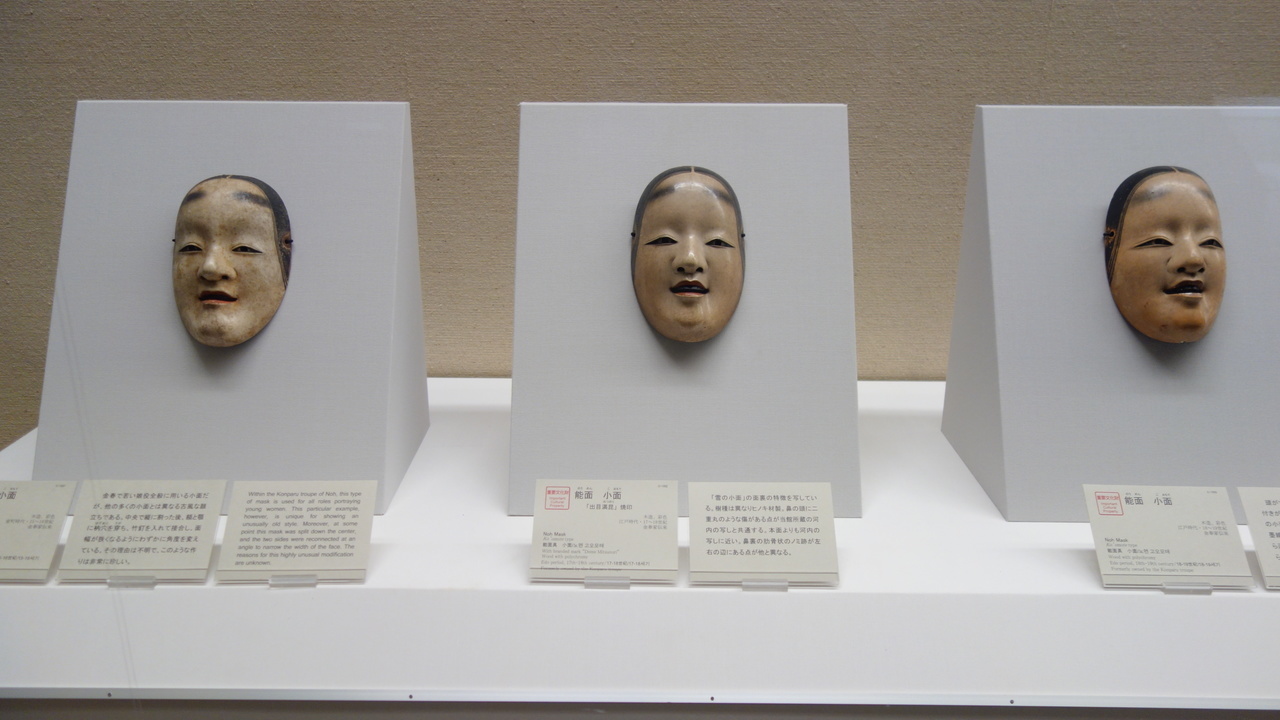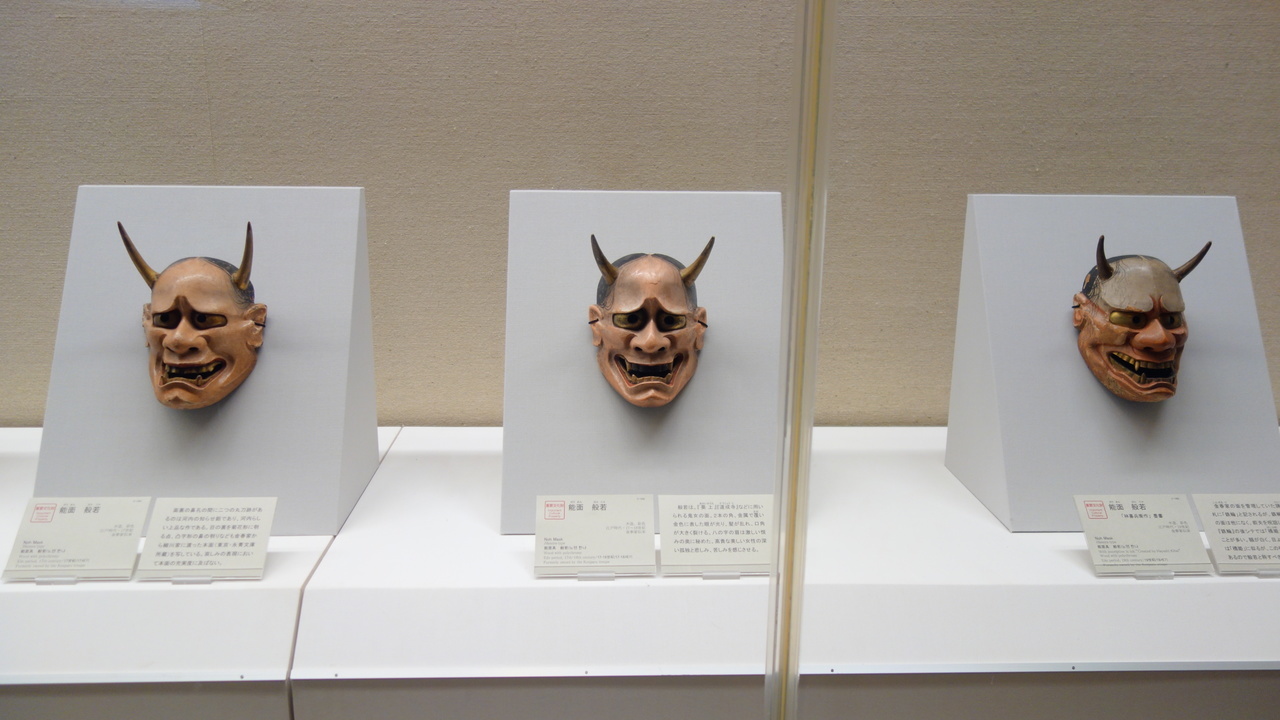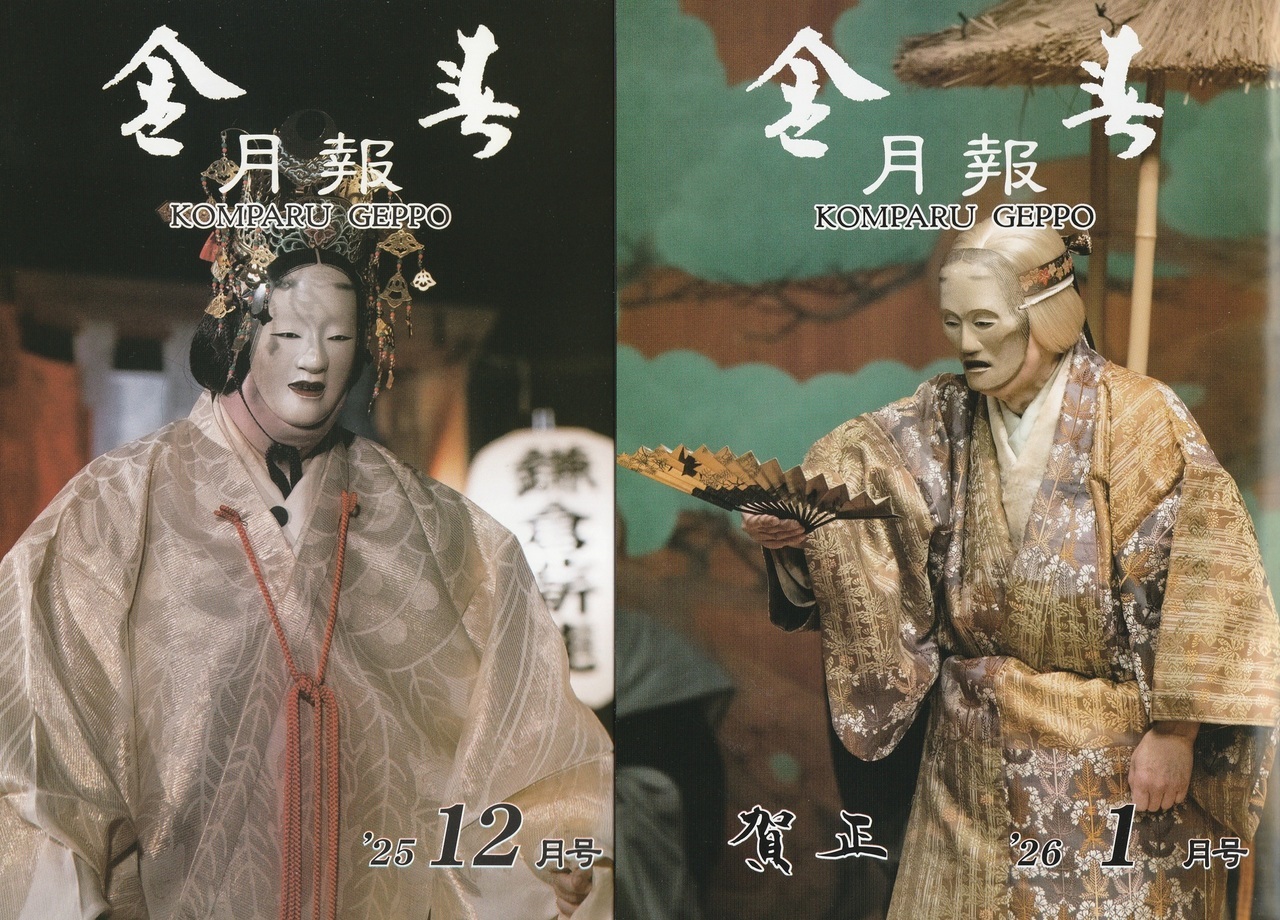Komparu School
The following is a brief introduction of KOMPARU-RYU (Komparu School),
the Noh school which is said to have the longest history among all schools
of Nohgaku <the generic name for Noh and kyogen combined>,
a traditional Japanese performing art.
With its accomplished sophisticated style, Nohgaku soars above others as
the pinnacle of classical performance arts of Japan. We welcome you to the
world of “Noh”, the oldest form of a musical on earth that lures you to a
realm of spellbinding fusion of utai <chant and chorus>, hayashi <music>
and mai <dance>.
August 7th, from 18:00 to 19:00 Nogaku Komparu Festival
The special street Noh perfomance by th Komparu School is held on August 7th, from 18:00 to 19:00, on the Komparu Street in Ginza 8-chome.
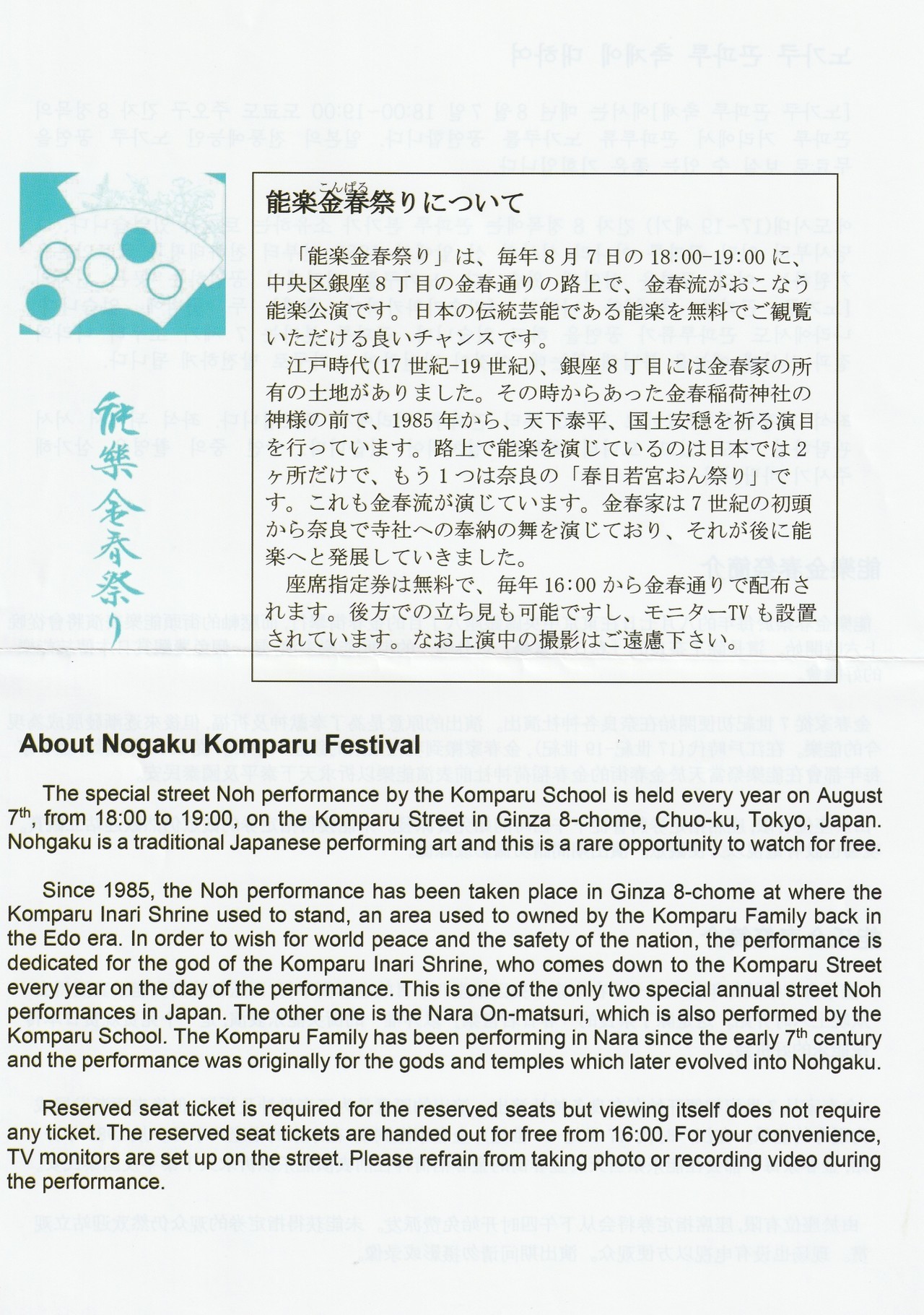
Experiencing Komparu School Noh performances
When and Where to See Noh Perfomances
of Komparu School
Information on the Komparu School Noh performances scheduled
in the coming months:
■September 10, 2023(Sunday)
Regular Noh Performance by Komparu School
Doors open at 11:45; Performance starts at 12:30;
You can buy tickets on the day. General Seating will be open seating.
Performance scheduled to finish at 17:20.
Three Noh plays: “Ebira” “Seiganji” “Ikkaku-Sennin”
At the National Noh Theater in Sendagaya, Tokyo
■September 10, 2017(Sunday)
Regular Noh Performance by Komparu School
Doors open at 11:40; Performance starts at 12:30;
Performance scheduled to finish at 17:00.
Three Noh plays: “Kasugaryujin,“Izutsu”and“Akogi”
At the National Noh Theater in Sendagaya, Tokyo
What is Komparu School?
The words passed down through hereditary succession has it that Komparu
School was founded around 600 AD by Hadano Koukatsu (the 1st generation),
who served Prince Shotoku, with the current iemoto <head of school>
Komparu Yasuaki being the 80th generation of the School. As such, Komparu
School is an unbroken lineage with the longest history among all schools of
Nohgaku. It is also the oldest school in terms of artistic style: Komparu
School is known to retain a wealth of time-honored formulaic styles, in both
utai <chant and chorus> and kata <movement patterns>. We hope you will
enjoy the simple yet sublime style of Komparu Noh.
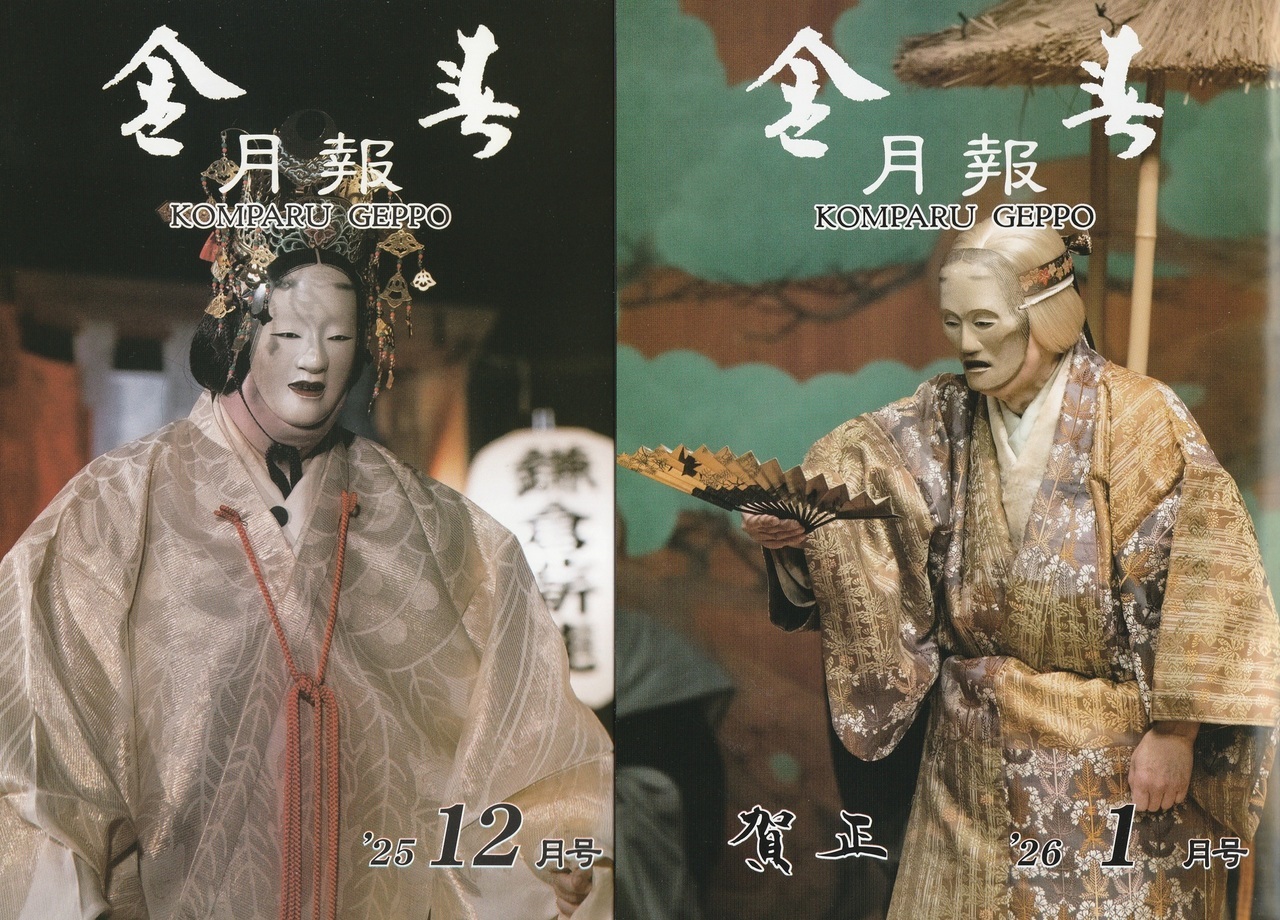
Enjoying a Noh Performance
Although Noh has been incorporated into the UNESCO Representative List
of the Intangible Cultural Heritage of Humanity, quite a few modern-day
Japanese people still tend to have the following perception of Noh as a
traditional Japanese performance art: “a bit low in action”; “difficult to pick
up the lines spoken”; “hard to know where the highlight of the drama lies”.
They also feel that “you need to have prior knowledge of all the set rules
in order to really appreciate Noh.” Admittedly, Noh comes with a lot of
conventions and rules. However, it is only the performers who are required
to stick to such conventions; in no way are these rules designed to facilitate
the audience’s understanding of Noh. To concentrate on what is taking place
onstage, irrespective of whether you “get it” or not, is probably the
recommended style of appreciating a Noh performance. Keeping your eyes
glued on the movements on the stage and straining your ears to the music
and the chant—while maintaining an open mind—is a shortcut to familiarizing
yourself to Noh. In other words, allowing oneself to be totally “absorbed” in
the dance movements and vibrant sounds of the music and the chant, and
finding “beauty” in the atmosphere created by the fusion of those elements,
is the key to enjoying Noh.
What Is Noh?
Noh is a form of theater. Often referred to as “music-and-dance
play” or “masque”, a Noh performance differs greatly from other
forms of theatric art in which the story unfolds mainly through
spoken lines. In contrast, a Noh play reenacts the inner thoughts
and emotions of human beings through song and dance. The sound
elements of Noh consist of verse/prose (known as “utai” ) and a
Noh orchestra comprised of a transverse flute, a small hand drum,
a large hand drum, and a large drum played with a stick. The “dance”
element is the locomotion pattern of the Noh actors. The sound
and the dance elements combined are capable of expressing a
whole spectrum of human emotions including delight, sorrow,
anger, resentment and hatred. Noh is also a theatrical art noted
for its frequent use of the mugen Noh (fantasy or dream Noh)
formula, in which the soul of a departed character enters the
dream of a living person to tell his or her story. A Noh play goes
well beyond simply reenacting the present reality; its mission is
to create a realm of a totally different dimension.
Above all, Noh is noted for its long and uninterrupted history
spanning many centuries. The art of Noh was perfected more
than 650 years ago, and the plays have been performed thereafter
without any period of lapse. This continuity has enabled Noh
plays to encapsulate the vivid sensitivity of people who inhabited
medieval Japan roughly around 1300 A.D. Being exposed to a Noh
performance allows us to tentatively entertain ourselves in a world
which is a complete departure from our day-to-day routine. The
polished verse and prose of medieval Japan; the rich emotions
highlighted by song-and-dance; the eloquence of the seemingly
“impassive” Noh masks; the piousness of people in those days
and their customs…there is so much we can learn from Noh.
Noh is built on a “less-is-more” approach. Throughout its 650-year
history, Noh has consistently trimmed away “frills” – whether in
masks, locomotion patterns or stage props – to arrive at Noh as
we know today. Just as a Noh mask which seemed to lack facial
expressions comes alive during a Noh performance, the slightest
movement can play infinite functions on stage. Noh is a form of
art that has acquired the ability to symbolize anything and
everything through “omission”. Moreover, every motion in a Noh
play can be broken down into units of “kata” <movement
patterns>. These “kata”, which count about 250 in total including
idiosyncratic ones, are highly simplified and abstract in style.
The Noh Stage
Roofed but located indoors, a Noh stage is surrounded by an
area covered with white pebbles—a vestige from an earlier time
when Noh used to be performed in open fields. It was only since
the Meiji period (1868 –) that a Noh theater building, with a Noh
stage completely fitted inside, came to be constructed. As a rule,
a Noh stage comprises a square of approximately six meters on
each side, with a column on each of the four corners. These
columns help the performers, whose field of vision is extremely
curtailed with the wearing of a mask, confirm their positions while
they are on stage. An aged pine tree known as “oimatsu” is painted
on a back panel placed at a position directly facing the audience
seats, while three small pine trees are planted along the bridge
extending on the left side of the stage. These props serve to retain
the atmosphere of an era when Noh was an outdoor performance.
All natural scenery is symbolized through this single factor of a
pine tree, which is an evergreen whose leaves remain verdant
throughout the year.
Attending a Noh Performance
What sets Noh markedly apart from other forms of theatrical
art is that, Noh is not a one-way experience in which only the
spectator is profoundly moved by the performance: The audience
is required to have the right frame of mind to not only immerse
themselves in the voice, music and movements that are being
performed but also to try to understand, and accept, the
atmosphere created by the fusion of all these elements.
On the other hand, there is another – and a more ingenious –
way of appreciating Noh, which is to enjoy Noh while dozing off!
Occasionally, during lapses from peaceful slumber, you turn your
eyes onto the stage and find yourself gazing at a “celestial
maiden standing there”; or “a woman living in the wilderness,
crouching over a spinning wheel in her tumbledown shack,
spinning threads of an endless cycle of reincarnation”; or “a woman
in male attire, elegantly flapping her kimono sleeves in a dance of
reminiscence of a love in bygone days”…. This is indeed a slumber
of the highest class.
The Mysteries of Noh
Noh is a form of art in which only “one (a small part) out of
ten (the whole)” is expressly demonstrated. During a Noh
performance, you come up with one question after another:
Why does everyone consistently wear only “shiro-tabi”
<Japanese white socks> onstage? ; Isn’t it strange to see
a man’s jowl peeking under a mask of a beautiful woman? ;
Kyogen performers always sit with their feet tucked underneath
themselves. Why do Noh actors sit with one knee raised?;
When did they decide on the 4-instrument composition of
the Noh orchestra?; Why is it that three out of the four musical
instruments are percussions, while the flute is also played
mainly as a rhythmic instrument?; Why isn’t the flute played to
harmonize with the tune of the utai?; Wasn’t copyright an issue
when the Noh plays created by Zeami of the Kanze troupe were
incorporated into the repertoires of other troupes? ..... Welcome
to the mysterious world of Noh! One of the joys of Noh is that
you find yourself sharpening all your senses to be perceptive
enough to “understand the whole from only one small part”;
in other words, you are launching yourself on a journey to solve
the mysteries of Noh.
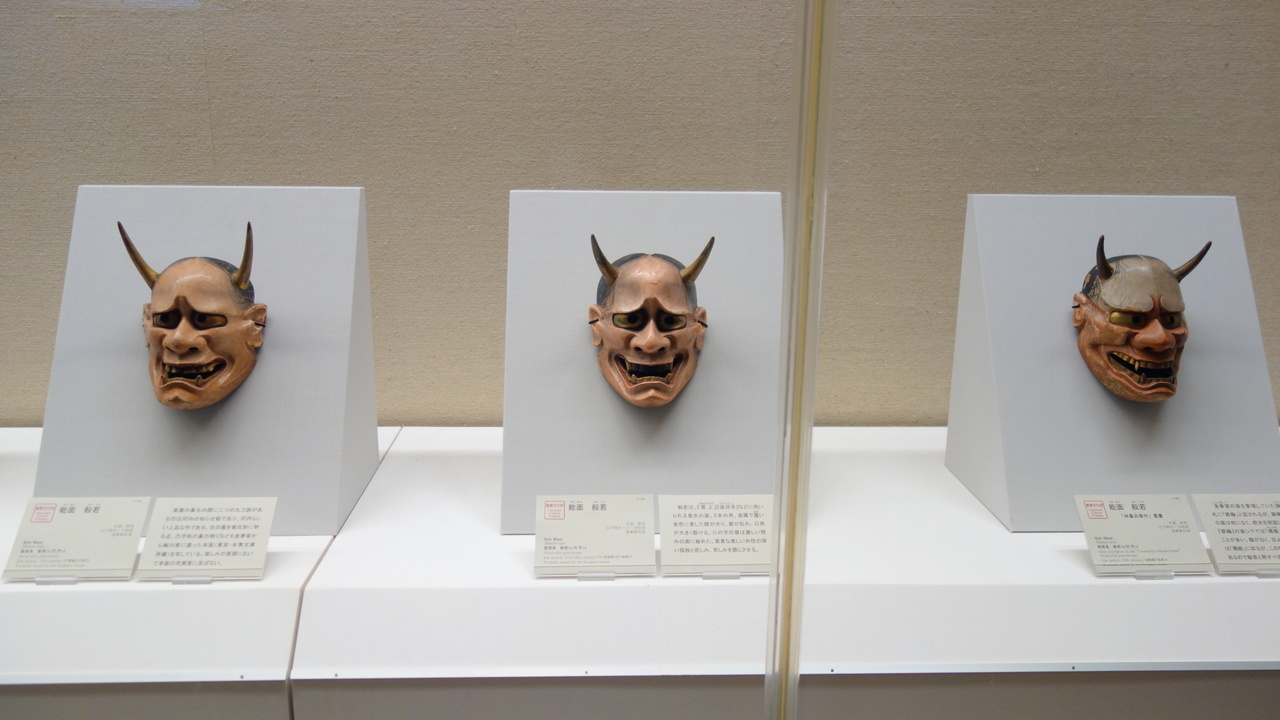
Roles in a Noh Play
The Actors
Shite-kata
Shite-kata is a lineage of male actors who play the main
character (protagonist) in a Noh play. Given the privilege of
wearing Noh masks onstage, they portray roles ranging from
men, women, old men and gods to oni <ogres>, tengu <long-nosed
goblins> and spirits of the departed. Shite-kata also provides
the Noh chorus known as jiutai, and is responsible for putting
together simple stage props. A Noh play is subdivided into two
parts, with the same actor playing the protagonists of both the
former and the latter parts, known as “mae-shite” and “nochi-jite”,
respectively. The secondary character co-acting with the shite is
called “tsure”. There are five schools of shite-kata including
Komparu School.
Waki-kata
Waki-kata is a role in a Noh play that consistently
represents a living male person. It is, in a sense,
a role that embodies the real world.
Kyogen-kata
Kyogen-kata are professionals who perform kyogen programs.
The main actor and supporting actor are called “shite” and “ado”,
respectively. Programs in which a kyogen actor performs a role in
a Noh play are referred to as “ai kyogen”, and those actors typically
portray characters who are even more real-world than the “waki”.
There are two schools of kyogen-kata: Okura and Izumi.
Hayashi-kata
Hayashi-kata is a generic term for the players of musical instruments
in Noh. Each performer exclusively plays one instrument, and never
an instrument other than his category. For each category of musical
instrument, there is more than one school.
The History of Noh
The World's Oldest Musical
Noh is believed to have been perfected in the Ashikaga
(Muromachi) period, more than six centuries ago, by Kan’ami
and his son Zeami. Up till that time, singing-only or lively
acrobatic acts presumably comprised the mainstream of
performance art in Japan. The credit goes to Kan’ami and
Zeami for picking out the “cream of the crop” of those arts
and incorporating them into a theatrical play driven by storylines,
in what may be called the world’s oldest “musical”. The verse
and prose performed in a Noh play today are almost identical to
those that were penned by Kan’ami and Zeami in their days.
It was in the year 1374 (or 1375) that the 3rd generation shogun
Ashikaga Yoshimitsu of Muromachi bakufu <feudal government>
had his first encounter with Noh at Imagumano shrine. Yoshimitsu’s
patronage and backing of Noh served as the key impetus for Noh
making a quantum leap forward. Incidentally, the English playwright
giant William Shakespeare was creating a sensation around the year
1600, which means that the musical theater genre in Japan was
already perfected 250 years before Shakespeare’s time.
Noh and Daimyo <feudal lords>
There is a reason why Noh managed to more or less retain its
original form while being passed down through centuries to the
present: The unstinting support from the power holders of each
era, namely the daimyo, had made this possible. It all started with
Ashikaga Yoshimitsu, the 3rd generation shogun of the Muromachi
feudal government, famous for commissioning the erection of
Kinkakuji (The Golden Pavilion), who was totally captivated by
the art of Kan’ami and Zeami. Subsequent feudal lords continued
to patronize Noh. In particular, Toyotomi Hideyoshi was a passionate
supporter of Noh, to the extent that in the 1590s he had his heroic
episodes dramatized into a Noh play, starring himself as the protagonist.
Hideyoshi also merged and closed down various Noh troupes throughout
Japan, slimming down the number to the four troupes based in Yamato
(Nara prefecture). These four troupes are the origins of the present-day
four schools of Noh (Kanze, Komparu, Hojo and Kongo). (The Kita School,
on the other hand, was founded by command of Tokugawa Hidetada,
the 2nd generation shogun of Edo period). By the time Tokugawa Ieyasu
came into power, the status of Noh had been further elevated to become
the official shikigaku (ceremonial music) of the shogun government.
Meiji Period (1869 – ) onward
The collapse of the daimyo (feudal lord) regime of Edo period brought
about much social chaos and distress. Meanwhile, the lifting of Japan’s
self-imposed isolation triggered an influx of foreign culture which, in
turn, led to the re-appreciation of traditional Japanese culture. One of
the central figures who pushed Noh toward its longstanding popularity
was Iwakura Tomomi, who renamed Noh as “Nohgaku” and introduced
it to the world as Japan’s proud tradition.
The incorporation of Noh into the 1st “List of the Intangible Cultural
Heritage of Humanity”, announced by UNESCO in 2001, has given
Noh another reason for attracting world-wide attention.
The History of Komparu School
Komparu Zenchiku, the 57th head of Komparu School nicknamed
“the restorer”, was the son-in-law of Zeami, the perfector of
Nohgaku. His close ties with Zeami (the 2nd generation Kanze
Dayuu) is evidenced by the fact that he personally inherited from
Zeami, through hereditary succession, such esoteric texts as “Rikugi”
and “Shugyoku Tokka”. Under the tutelage of his father-in-law Zeami,
Zenchiku followed in his footsteps and further advanced the
formidable achievement made by Zeami in driving Noh toward its
perfected form. Among Zenchiku’s own accomplishments are such
masterpiece Noh plays as “Basho” and “Nonomiya” and a long list
of esoteric books including “Rokurin Ichironoki” and “Meishukushu”.
Going down the lineage from Zenchiku, Komparu School continued
to turn out a number of outstanding figures, including the 59th head
of school Komparu Zenpou. Worthy of special mention among them
is the 62nd generation head of school Komparu Yasuteru, whose
artistic style flourished under the protection and aegis of Toyotomi
Hideyoshi. After Tokugawa Ieyasu took over as the ruling shogun,
Yasuteru continued to be treated with special respect as the eldest
dayuu <prominent Noh actor> of the four troupes (Kanze, Hosho,
Komparu and Kongo), which further reinforced the important position
held by Komparu School in the history of Noh. Ranked second to Kanze
troupe in hierarchy, Komparu School in Edo period nevertheless had
under its command many influential branch families – Komparu
Hachizaemon, Takeda Gombei and Okura Dayuu, to name a few.
Today, the prestigious Sakurama family is one of the branch families
who are carrying on the refined style of Komparu School Noh.
Tokyo, Nara, Nagoya, Kumamoto, Fukuoka and Kagoshima are the
main present-day hubs of activity for Komparu School.
The current iemoto, the 81th generation Komparu Norikazu,
heads a public-interest incorporate association called
Komparu-Enmaikai, named after the Enmaikai troupe which
was one of the four enormously successful troupes of sarugaku
<prototype of a Noh play> of Yamato in mid-14th century.
Although Hadano Koukatsu is said to be the founder of Komparu
School, the first person to actually use Komparu as a surname
was Komparu Gonnokami who was the 53rd generation down
the lineage. Gonnokami did not inherit the school as head, but
his son Yasaburo was picked out as the 56th head of Komparu
School, and his line of descent continues to the present day.
